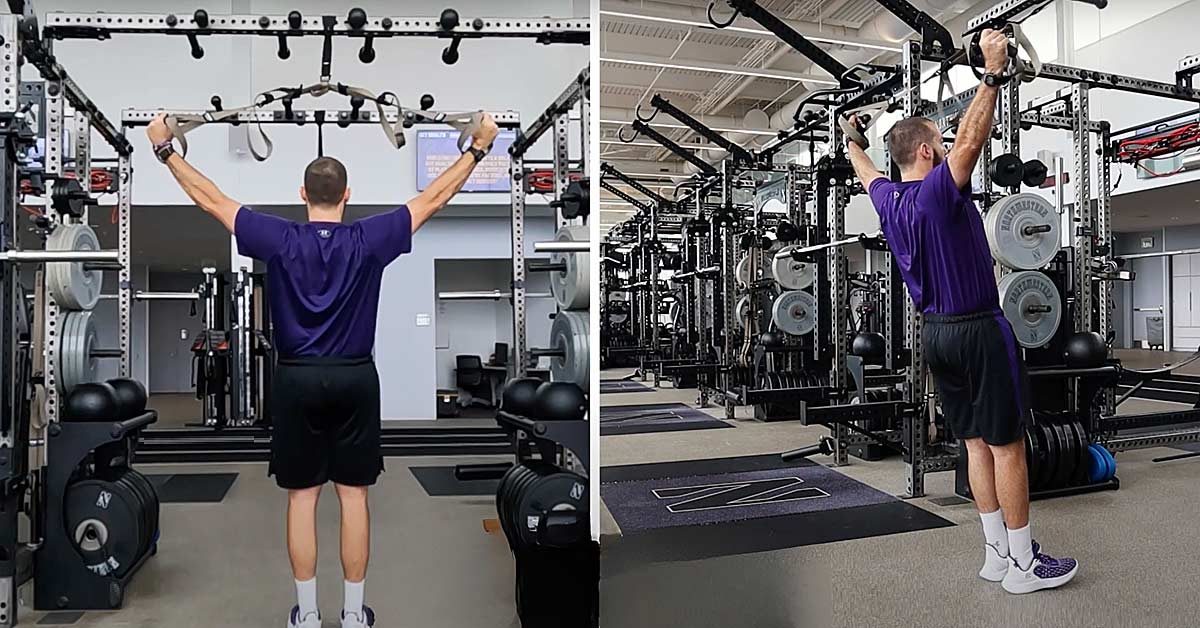
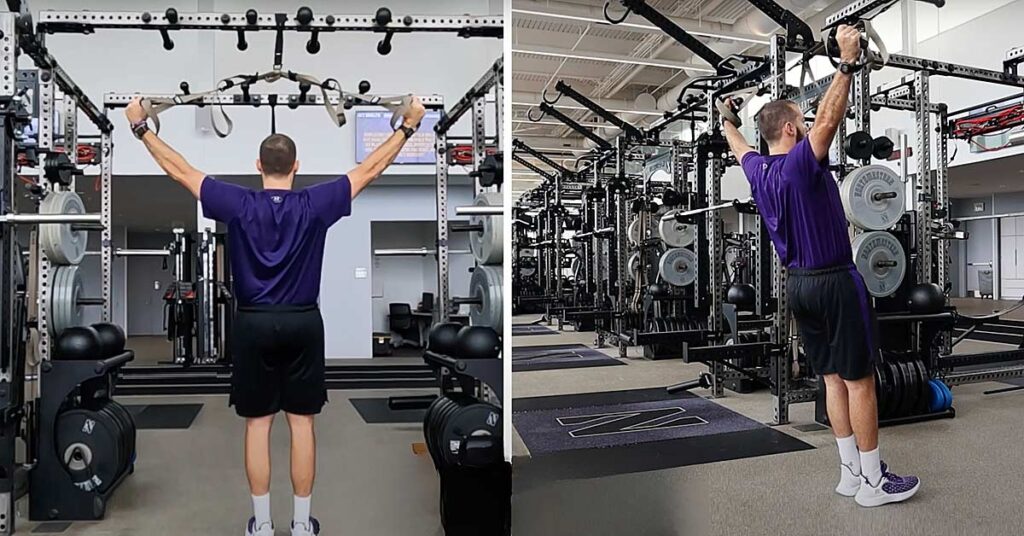
One in all my favourite issues about this area is when actually good coaches can boil down large, complicated matters into easy, digestible phrases. For me, Eric Cressey’s abstract of shoulder care was a lightbulb second: shoulder care is about “conserving the ball on the socket.”
On the finish of the day, the ball of the humerus has to remain on the socket of the scapula, making the glenohumeral (shoulder) joint. With all of the stresses we placed on the shoulder in overhead sports activities, how will we put together the shoulder joint to take care of its integrity (ball on socket) as finest as doable for so long as doable?
“Overhead athletes” as a class consists of baseball, softball, volleyball, and tennis gamers, soccer quarterbacks, and swimmers, to call only a few. Since most of my expertise has been with baseball athletes, that’s the lens I’ll use to border this text. Nonetheless, it’s 100% value mentioning that I’ve utilized all of those ideas to my swimmers and consider that effort positively affected their shoulder well being.
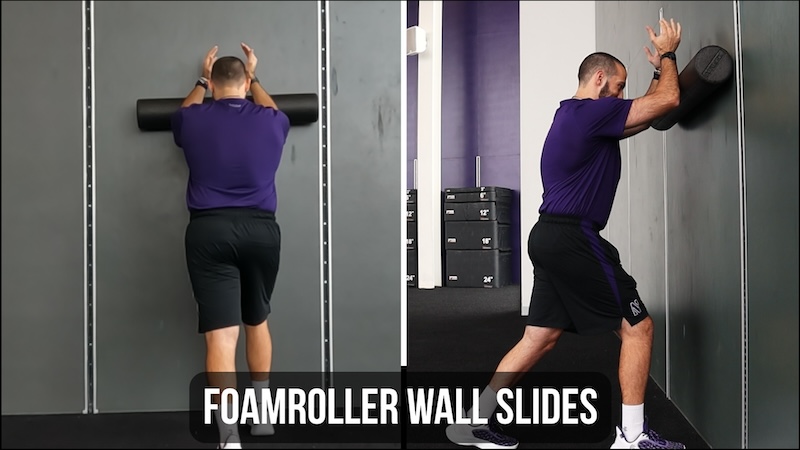
With this straightforward but common thought of “conserving the ball on the socket,” we should perceive the throwing movement and all of the calls for it places on the shoulder joint that threaten joint integrity. The 2 most demanding actions are layback (max exterior rotation) and ball launch (shoulder protraction and upward rotation), the place probably the most eccentric stress occurs. That simply means when the arm switches muscle actions shortly, first going from cocking the arm to accelerating the baseball ahead, and second from baseball launch to decelerating the arm. (This could additionally apply to hitting a volleyball or serving a tennis ball.) These forces make the arm need to fly off the shoulder, and we have to put together the muscle mass to not let that occur, or “preserve the ball on the socket.”
Nevertheless, it’s essential to take into account that throwing is a total-body movement and entails the kinetic chain, with floor response forces going up the leg, to the hips, via the torso, to the ball, and ending via the arm. Moreover, the scapula (half of the shoulder joint) will largely dictate what the arm (humerus) is ready to do.
Let’s view this ‘shoulder care’ topic as a total body puzzle that requires good scapular movement and strength of the rotator cuff through both specific and large ranges of motion, says @CoachBigToe. Click To Tweet
In the end, throwing makes use of all the kinetic chain—so no matter sure joints can’t do that’s required to throw, totally different areas of the physique will compensate to determine it out/make it occur. And likewise, regardless of the scapulae can’t do, the humerus will strive to determine by itself. So, let’s view this “shoulder care” subject as a complete physique puzzle that requires good scapular motion and power of the rotator cuff (4 muscle mass largely concerned with ball-on-socket stability) via each particular and huge ranges of movement.
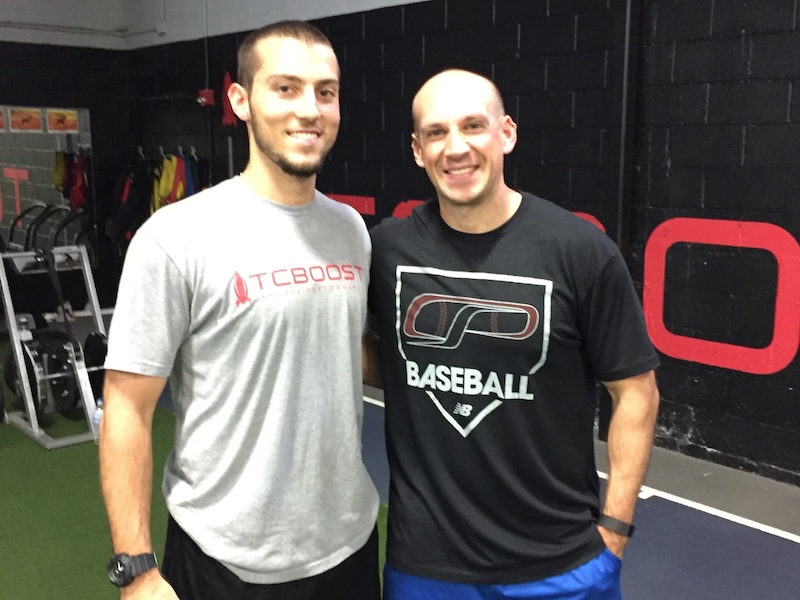
On this article, I’ll take you thru my framework of organizing and programming shoulder care workouts. Earlier than transferring on, I need to give an enormous shoutout to Eric Cressey for all the things he has performed for this area. Personally, I’ve slowly accrued nearly all of my data on this subject via being a fan and client of his content material over the past 7+ years. Though that is my interpretation and utility of his data, it wouldn’t be doable and not using a strong basis first.
Video 1. This may assist illustrate the ideas beneath, together with nearly the entire particular workouts. It is a very visible subject in nature, so please reference the video as wanted to know the content material totally.
Train Classes
(at 0:18 in video, with video examples at 2:52)
Not all shoulder care drills are created equal. Some require exterior load, some use associate resistance, some are held for a protracted interval, some are perturbations to construct proprioception, some are meant for low season improvement, and a few are higher suited to in-season coaching.
Though the ideas beneath are common, not each kind of train listed beneath will 100% cowl all of the doable workouts you are able to do. That is only a place to begin constructing your train library and understanding the variables that underpin train development, as these classes are listed in principally development order.
Finish-Vary-of-Movement Isometric Holds
Though we stay most of our lives in the midst of most joints’ vary of movement, accidents typically occur once we take these joints to the intense ranges of movement the place they’re weakest. Athletes are typically required to be in these finish ranges of movement, which regularly embrace a whole lot of power and a time constraint (e.g., performing quick to finish a play). So, the joint needs to be robust in a weak place and nonetheless have time to stabilize or carry out the motion.
Finish-range-of-motion isometric holds are nice for constructing a while underneath stress in these comparatively weak positions, in addition to bettering the vary of movement in that joint. Such a drill is sensible within the early low season to begin constructing capability and power in these joints. Progressions embrace longer holds or including a weight.
Managed Articular Rotations
Constructing on the end-range-of-motion isometric holds above, managed articular rotations apply the identical logic however are for all the joint, not only a singular joint motion. This principally applies to joints with the biggest vary of movement: the hips, shoulders, and the scapulothoracic joint. In a gradual and measured method, managed articular rotations take that joint via the biggest vary of movement doable, actually utilizing the muscle mass to seek out the intense ranges of movement.

CARS take advantage of sense within the early low season to construct capability and power in these joints and a better vary of movement. Moreover, you possibly can apply these drills in any warm-up (in a decrease rep style) to completely heat up the joint or as an lively restoration exercise to revive doubtlessly misplaced vary of movement in that joint. Progressions could be including a weight or just simply reaching a wide variety of movement.
Concentric Raises
That is in all probability what most individuals consider once they consider a rep of an train: a complete rep of each the up and down, managed the entire time however not specializing in a selected section. What most individuals don’t perceive is that concentric muscle motion is the weakest a part of the muscle motion in comparison with eccentric and isometric muscle actions. Raises work properly as a easy method to groove that motion sample via a full vary of movement and for a average to massive variety of reps.
What most people don’t understand is that concentric muscle action is the weakest part of the muscle action compared to eccentric and isometric muscle actions, says @CoachBigToe. Click To Tweet
Rhythmic Stabilizations
There’s a much-repeated quote from Bruce Lee I’ll use as an instance the problem of coaching for sport: “I concern not the person who has practiced 10,000 kicks as soon as, however I concern the person who has practiced one kick 10,000 occasions.” Effectively, that’s not precisely how sport is performed. I’m not one to critique a legend, however it’s an fascinating idea to play off. In sport, there’s a whole lot of unpredictability inside practising and performing comparatively the identical actions.
Video 1. A snippet of two rhythmic stabilization shoulder care drills the place the associate faucets the athlete’s arm whereas they struggle to withstand the movement.
Pitching could be a “closed chain” motion the place the athlete initiates the motion on their very own and doesn’t must react, permitting them to observe the identical throw 10,000 occasions. Nevertheless, pitchers have a number of pitches; they need to react and throw whereas enjoying protection, their rhythm and timing can get tousled once they’re taking note of runners on base, and so forth. Due to this fact, they want their throwing muscle mass, all the kinetic chain, to be robust and protected in quite a lot of positions.
Hitting and protection could be an “open chain” motion the place the athlete has to react to the pitch, the batted ball, and many others.—principally, no swing or defensive motion is strictly the identical. So, all the kinetic chain for each rotation in swinging and operating on protection needs to be robust and protected in quite a lot of positions.
Ethical of the story: as a efficiency coach, I’m right here to make athletes and never “baseball gamers.” I want to arrange my athletes for the entire unpredictable parts of sport, together with all of the joints (shoulder, hips, scapulothoracic, and many others.) and muscle actions required to be prepared and sturdy to deal with that.
Rhythmic stabilizations are unpredictable, partner-administered perturbations to a joint in a selected place. In different phrases, the associate applies faucets in a random sample of each timing and power to attempt to transfer the physique half/joint out of place whereas the athlete tries to remain nonetheless, preventing the faucets.
Rhythmic stabilizations are great for developing the proprioception of muscles to react to the unpredictable movement demands placed on them in sports, says @CoachBigToe. Click To Tweet
Such a drill is nice for growing the proprioception of muscle mass to react to the unpredictable motion calls for positioned on them in sports activities. The athlete must be robust and secure inside all the assorted positions within the second from the associate perturbations. These drills take advantage of sense in lively restoration and in the midst of the low season as a development of isometric holds.
Eccentrics – Each Submaximal and Supramaximal (Accomplice-Assisted)
Eccentric muscle actions happen when the muscle mass actively lengthen and the joint angle of the muscle mass concerned will increase. Take into consideration decreasing the load throughout a bicep curl or controlling the descent on a squat. Such a muscle motion is utilized in each throw, each swing, and each stride in sprinting, most frequently when deceleration occurs in that motion.
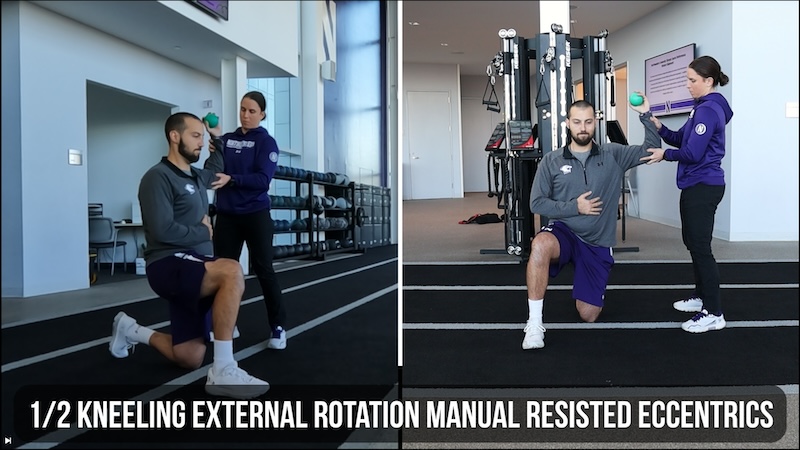
Additionally, eccentric muscle actions are when muscle mass can produce probably the most power and, consequently, develop probably the most power. It’s a fantastic problem to take care of posture and joint positioning whereas controlling eccentric muscle motion, particularly with maximal intent. Inside eccentrics, there are two primary sorts:
- Yielding eccentrics are at submaximal depth; take into consideration yielding like a squat you possibly can management on the best way down for a selected period (like 4 seconds), then squat it again up.
- Supramaximal eccentrics are with forces above an athlete’s muscle mass’ capabilities to isometrically or concentrically resist the power; take into consideration supramaximal like a squat heavier than a one-rep max which you can solely management happening however can’t maintain on the backside or squat again up.
Submaximal eccentrics make sense in the midst of a coaching program to progress from isometric holds, and supramaximal eccentrics make sense on the finish of a program as probably the most forceful and difficult kind of drill your athletes can do.
I listed these train classes from easy to complicated and in an order fairly much like how I’d progress them in a program. As I get into the shoulder-specific classes beneath, attempt to envision how the classes above apply to create a structured and logical development of workouts.
Shoulder Care Classes
(at 1:40 within the video, with issues at 9:05)
Exterior Rotation
As talked about earlier, max exterior rotation may be very demanding on the shoulder joint. This occurs because the torso and shoulder begin to rotate ahead whereas the arm and hand transfer backward, creating a whole lot of eccentric stress and whip-reversing the momentum of the baseball/arm.
Additionally, a giant lightbulb for me from Eric Cressey is that in exterior rotation of the shoulder joint, the ball of the humerus needs to additionally glide ahead (which may trigger irritation within the entrance of the shoulder). So, the first goal of exterior rotation drills is to strengthen the rotator cuff in positions of shoulder abduction and exterior rotation (elbow up at 90 levels in conjunction with the physique).
Drills and Examples
- Inclined exterior rotation lift-offs.
- Chest-supported exterior rotations.
- TRX exterior rotation holds.
- Banded exterior rotation walk-outs.
- Half-kneeling ER banded press and raises.
- Half-kneeling shoulder exterior rotation associate stabilizations.
- Half-kneeling shoulder exterior rotation handbook eccentrics.
Video 2: A snippet of some issues to bear in mind when programming your shoulder exterior rotation drills to ensure you’re working the proper muscle mass and the workouts make sense within the large image of the coaching week.
Concerns
I like to avoid wasting my exterior rotation workouts for the final day of the coaching week. It is sensible to me that the rotator cuff is extraordinarily essential to maintain the shoulder joint secure throughout throwing, so I want it as contemporary as doable through the week. Then, on the coaching week’s final day, I can actually fatigue these muscle mass of my athletes with upcoming relaxation the following few days.
Moreover, you will need to keep away from “ahead dumping” of the ball of the shoulder, which may trigger pinching within the entrance of the shoulder. Take heed to conserving the ball of the shoulder sq. in the midst of the shoulder joint.
Posterior Tilt
The posterior tilt might be one of the crucial underappreciated actions that the scapulothoracic joint (scapulae on the rib cage) must do properly. Take into consideration this in a traditional shoulder “Y” place: for the arms to go each above and behind the athlete’s head, the highest of the scapulae wants to maneuver backward whereas the underside stays nonetheless. Good posterior tilt will assist the athlete obtain higher exterior rotation at layback. One of many primary muscle mass serving to to carry out this motion is the decrease trapezius, so what I name a “Y elevate” others could name a “low lure elevate.”
The posterior tilt is probably one of the most underappreciated movements that the scapulothoracic joint (scapulae on the rib cage) needs to do well, says @CoachBigToe. Click To Tweet
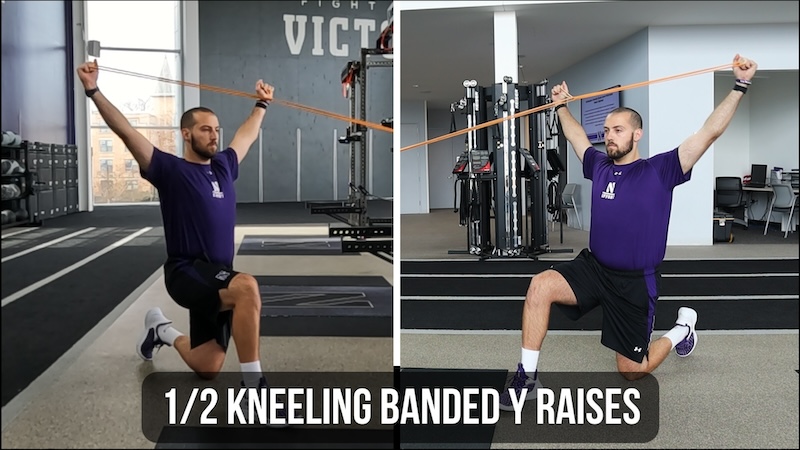
Drills and Examples
- Chest-supported Y raises.
- Banded half-kneeling Y raises.
- Banded Y walk-outs.
- TRX Y holds.
- TRX Y eccentrics.
- Chest-supported shoulder Y stabilizations.
Concerns
There are lots of muscle mass that work on the shoulder and scapulothoracic joint, however we have to preserve the principle ones doing their job when engaged on particular actions. There’s a whole lot of overlap in muscle attachments and capabilities; with 17 muscle mass that connect to the scapulae for eight primary actions, understanding what muscle mass we don’t need working is simply as useful as understanding which of them we do.
The higher trapezius (in all probability what most individuals consider because the “lure” muscle) additionally helps elevate the shoulder blade, however we’d like that muscle to remain off throughout our Y workouts. On the flip facet, the lats helps convey the shoulder blade down in order that muscle must calm down to let the arm go overhead.
Protraction/Upward Rotation
I perceive the priority about not eager to overdo overhead workouts as a result of the athletes are in that place a lot throughout sport, however I’d argue that utterly ignoring these workouts for that purpose does extra hurt than good. It’s essential to reveal them to overhead positions and problem their means to be robust and secure in them, growing the muscle mass they’ll use once they go overhead in sports activities. Bear in mind, it’s not the poison itself that’ll get you (the train); it’s the dose (how a lot).
Remember, it’s not the poison itself that’ll get you (the exercise); it’s the dose (how much), says @CoachBigToe. Click To Tweet
As talked about earlier, the scapulae operate will dictate the arm’s means to go overhead in a wholesome and sustainable approach. Once more, from Eric Cressey, we’d like the scapulae to have the ability to “attain, spherical, and rotate” in regards to the rib cage; spherical means protraction (the alternative of pinching your shoulder blades, so it appears to be like like rounding your again), and rotate means upward rotation. The primary muscle for this motion would be the serratus anterior, serving to convey the shoulder blades from behind the physique to in entrance across the rib cage.
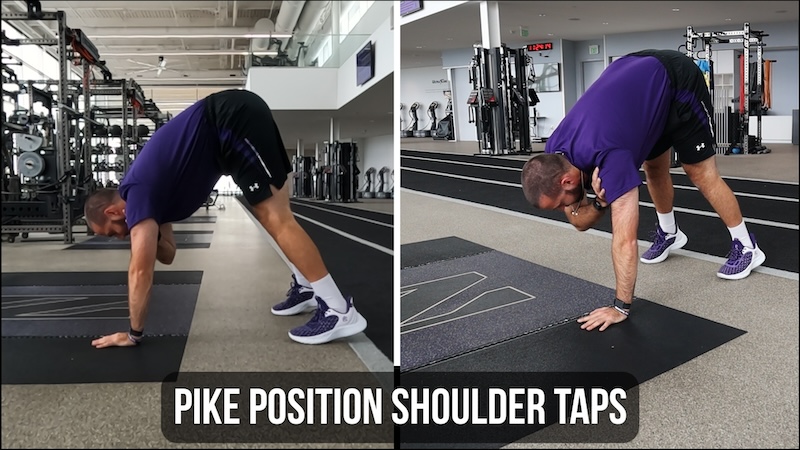
Drills and Examples
- Banded cat-cow.
- Banded cat-cow walk-outs.
- Foam curler wall slides.
- Pike place holds.
- Push-up place to reverse toe contact.
- Pike place shoulder faucets.
- Pike place inchworms.
- Backward pike place strolling.
Concerns
As listed above for our posterior tilt workouts, we’d like the correct muscle mass to do the correct job. Retaining large muscle mass just like the higher lure and lats off permits smaller muscle mass just like the serratus anterior to operate appropriately. This, in flip, creates good motion habits, which will increase the longevity of athletes going overhead.
Thoracic Backbone (T-Backbone)
The primary of the 2 classes that doesn’t (instantly) contain the shoulder is the thoracic backbone. As acknowledged above, the thoracic backbone is extraordinarily essential to assist the scapulae work as successfully as doable (scapulothoracic joint); this, in flip, will assist the arm transfer extra effectively. The thoracic backbone—or the center 12 vertebrae of the backbone, every of which has ribs hooked up—must flex/prolong and rotate.
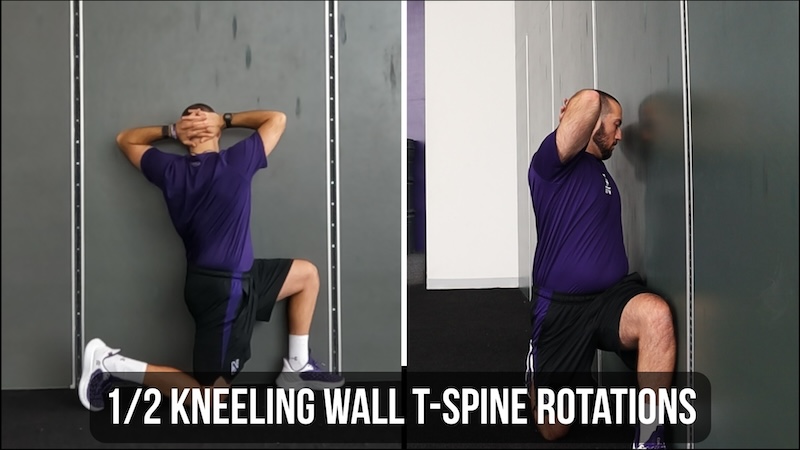
With the ability to prolong the thoracic backbone will assist with getting the shoulder into exterior rotation at layback and flexion, which helps get the arm in entrance of the physique for ball launch. Lastly, rotation of the thoracic backbone helps with hip-shoulder separation, which is crucial for an efficient kinetic chain when throwing.
Drills and Examples
- Aspect-lying t-spine windmills.
- Quadruped t-spine openers.
- Seated twist-bend-breathes (which I shamelessly stole from the Titleist Efficiency Institute).
- Half-kneeling wall rotations.
Concerns
The t-spine has to operate in quite a lot of totally different pressures, if you’ll. The athlete has to remain easy and fluid, moving into a superb attacking place (like earlier than spiking a volleyball or layback in a baseball throw). However then the athlete wants to modify into propulsion by creating stress and accelerating the arm/ball ahead. The breath will probably be crucial—exhaling to be relaxed to permit new ranges of movement and in addition inhaling to power the ribs to broaden in that new vary of movement. I coach my athletes to breathe out whereas moving into the top vary of movement and to breathe in to create a brand new vary of movement.
Moreover, the workouts talked about above are primarily for t-spine rotation, whereas cell and ample flexion and extension are additionally required of the t-spine for overhead athletes. Nevertheless, many protraction/upward rotation workouts additionally work on the flexion/extension of the t-spine.
Hips
The second class that doesn’t contain the shoulder is the hips. The case for this class is extraordinarily much like the thoracic backbone; working up the kinetic chain, the hips have to internally rotate, externally rotate, and prolong for efficient rotation to stand up the remainder of the physique.
What the hips can’t do will either lead to decreased rotation effectiveness (less velocity) or cause other joints up the kinetic chain to compensate and do things they weren’t made to do. Click To Tweet
What the hips can’t do will both result in decreased rotation effectiveness (much less velocity) or trigger different joints up the kinetic chain to compensate and do issues they weren’t made to do. What the hips can’t do may even result in the lumbar backbone compensating, then the thoracic backbone, then the scapulae, then the shoulder joint, and so forth.
Drills and Examples
- Hip 90/90 inner and exterior rotation lift-offs.
- Quadruped hip CARS.
- Rack-supported standing hip CARS.
- Hip 90/90 heel faucets.
- Hip 90/90 switches (no palms).
Concerns
When engaged on very particular actions and joint actions, it’s very simple for compensations and different muscle mass to take over. It’s essential to not rush via these workouts and to take heed to minimizing motion of the remainder of the physique.
Different
Not each shoulder care class and drill will match cleanly in an train class. Listed below are two drills I like, each managed articular rotations, that don’t have a transparent shoulder care class.
Programming Shoulder Care Workouts
From all the knowledge above, the actual problem stays: how will we manage these workouts inside every week to develop these muscle mass in coaching with out rising the chance of harm or taking away from the flexibility to play the game itself at a excessive stage resulting from extreme fatigue? These muscle mass are used for a number of hours a day in observe with each throw and swing, so we have to be aware about not overdoing it.
With that being stated, there’s really no proper or unsuitable when programming these workouts so long as you will have logic and justification for making the alternatives you make.
I like to recommend supersetting these workouts with non-competing muscle teams/workouts. As bizarre as it would sound, shoulder care workouts work nice to program on lower-body days. For instance, after hitting a heavy set of squats, would pairing hip-controlled articular rotations assist or damage the following set of squats? I’d argue that it will damage, as these hip muscle mass want as a lot restoration as doable to maintain the principle factor the principle factor (squatting heavy). Pairing a squat with a shoulder exterior rotation or protraction train would make extra sense, as these muscle mass aren’t used throughout a squat.
Moreover, in case your applications are already tight on time and maximized for effectivity of extra main train choice, you possibly can simply add these workouts right into a warm-up or cool-down as a not-very-time-intensive method to construct frequency and publicity to those workouts. These may also be added to lively restoration/mobility circuits on off-days.
As there’s no excellent program, I consider it’s additionally useful to debate when to not carry out these workouts. I’m a believer in following a high-low coaching mannequin, principally making an attempt to consolidate your stress to make your exhausting days exhausting and lightweight days gentle.
With this in thoughts, I’d think about a giant pitching outing—for instance, greater than 100 pitches—a really hectic occasion for the arm and physique. Consequently, post-game in all probability shouldn’t embrace these workouts. However on the flip facet, a medium-sized outing—like 40 pitches—would possibly warrant performing a number of the extra hectic workouts if the coach says the athlete gained’t pitch the following day. These workouts are used to show a “medium” depth day right into a “excessive” depth day, setting them up for a pleasant restoration day the following day. Moreover, workouts like managed articular rotations would match very properly in an lively restoration mobility circuit, aiming to regain misplaced vary of movement the day after pitching.
Is that this to say this text consists of each train, variation, kind, and class of shoulder care?
Completely not. Will each drill match cleanly into one in every of these classes? Nope. Are there workouts I’m studying and experimenting with that can develop my arsenal each week? Completely.
What I outlined here’s what works for me with my athletes, each effectively and successfully for my teaching/programming model and having 35+ athletes within the facility I practice at. However what I hope for you is that this text offers you a framework and start line to arrange your ideas and enable you to write your applications extra effectively. These ideas and ideas are common in coaching and programming, however seeing a number of the construction and thought processes behind them would possibly simply be what it’s essential to take your shoulder care to the following stage.
Because you’re right here…
…we’ve got a small favor to ask. Extra persons are studying SimpliFaster than ever, and every week we convey you compelling content material from coaches, sport scientists, and physiotherapists who’re dedicated to constructing higher athletes. Please take a second to share the articles on social media, have interaction the authors with questions and feedback beneath, and hyperlink to articles when acceptable in case you have a weblog or take part on boards of associated matters. — SF

